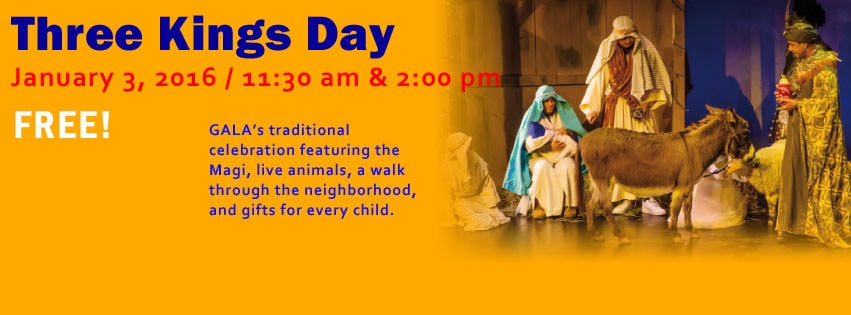“We Three Kings of Orient are;
Bearing gifts, We travel afar,
Field and fountain, moor and mountain,
Following yonder Star.”
The words of this iconic Christmas Carol will come alive for the 40th year, this Sunday, January 3, 2016, in the Latino “corazon” — the heart of Columbia Heights — on 14th Street NW.
In its annual, colorful, traditional celebration of The Adoration of the Magi — that ancient and modern Christian trope — this open-air tribute will be staged, as always, as a fiesta, bilingually and as street theatre for the entire family, by GALA Hispanic Theatre.
Actors play the parts of the three mythic “Kings” — or los Reyes Magos — and their guiding Angel who leads them to the infant, in the manger. All will process, following that “star of wonder, star of night,” including also a procession of live animals, in a walk through the 14th Street NW neighborhood, as gifts are distributed for every child.
The procession (or “desfile”) will take place twice, at 11:30 AM and 2 PM. The Kings, the Angel, and the live animals (including donkeys, goats, and sheep) will begin at the corner of Park Road and 14th Street, telling the timeless tale of the worshipful Magi, or Wise Men, led by a guiding star to the foot of the manger.
Tickets are needed, but distributed first-come-first-served, and are free for the entire family. The tickets can be obtained at the GALA Hispanic Theatre – 3333 14th Street NW, in Washington, DC at 10 AM — for the 11:30 procession — and at noon — for the 2 PM procession. Refreshments will be served after each performance.
The festival will be, as always, powerful and picturesque street theater, drawing especially the attention of children wide-eyed at the excitement and drama of the sight of the kings and the angel and the animals recreating the ancient ritual, the “adoration” of the young infant around whom so much of this season revolves, but also excited that a gift will soon be theirs.
Yes, attendance at the event is “free,” but a small gift for children is suggested, to be left at the GALA box office at the time tickets are distributed there.
Starring in this theatrical are three actors portraying the “kings” — Bienvenido Martinez as “Balthasar,” Jose Suerio as “Gaspar,” Hector Diaz as “Melchior,” and also Neena Krutha as “the angel.” The host is Alejandro Negron, the TV anchor of “Hispanic Agenda”: on News Channel 8 and Telemundo.
In addition, entertainment will include the Honduran singer Maria Isolina, and los Quetzalitos (a youth Mexican dance company, directed by Laura Ortiz), and the popular dance group Alma Boliviana.
“It has always been part of our mission to maintain the traditions and cultural vitality of our Latin American countries,” says Hugo Medrano, GALA’s co-founder and Producing Artistic Director. “By doing so, we are promoting tolerance and inclusion, and stimulating a sense of imagination, identity, and cultural pride in our young people.”
Past attendees at the event have said that it is grounded in Latino spirituality and community. As such, it forms a touchstone for ways we connect, spiritually, with the birth of a king. As a people, in other words, and not only for Latinos, the quest now is not for a secular Messiah, but instead for a Messiah of salvation, a Messiah of plowshares, not the sword, both for individuals and their communities, and of course especially for the children. What GALA — an acronym which stands for Grupo de Artistas Latino Americanos, celebrating its own 40th anniversary this year — creates in this event is “theatrical” writ large. It is almost a medieval “morality play,” but one brought into the modern world, stepping out of myth and into the streets of DC, and made sensible to everyone, not just the faithful.
The GALA Theatre is located in the Tivoli Building, one block north of the Columbia Heights Metro Station (on the green and yellow lines). Discount parking is available at the nearby Giant Supermarket parking lot on Park Road, with validation provided at the GALA box office.
There’s interesting background to how the Three Kings came to be, much enhanced from the spare detail provided originally only in the Gospel according to St. Matthew, chapter 2, verse 11. The song we all know carries much more detail, including the fact that there were three kings, something never mentioned in scripture. The song was written in 1857 by an Episcopalian priest, John Henry Hopkins, Jr., the rector of Christ Episcopal Church in Williamsport, PA.
The Hopkins song, with its sad melody, adds much to the original in St. Matthew, shaping the common lore of today about how the Magi — or Wise Men — found the infant and paid him homage. Their names never appear in the Bible, nor in the original was it even said that they were kings. It was only during the Middle Ages that the legend of the royal quest for the birth of Jesus came to be, based largely on folk traditions of the time. The additional details were added, almost certainly, to press the point that Jesus was recognized, from his earliest infancy, as King of the Earth.

Eventually “the adoration of the wise men” came to be celebrated in the Western church as the Feast of the Epiphany on January 6, 2016. Meanwhile, in the Eastern Orthodox Church, it is celebrated on December 25.
The so-called “Adoration of the Magi” at the crib was also a favorite subject of Christian art, medieval as well as Renaissance — and was the subject of masterworks by Fra Angelico, Botticelli, Bruegel, Durer, Leonardo da Vinci, Rubens, and Veronese, among others. Typical iconography in these paintings includes a fair diversity of animals, the ox and the ass (or donkey), of course, but also frequently included camels, as well as the falcons that might accompany kings and their retinues. From the 15th century on, the kings might also be conflated with the shepherds, found in the account in Luke’s Gospel, chapter 2, verses 8-20.
More recently, the kings feature in one of the most popular operas of all time, Gian-Carlo Menotti’s Amahl and the Night Visitors in(1951).






